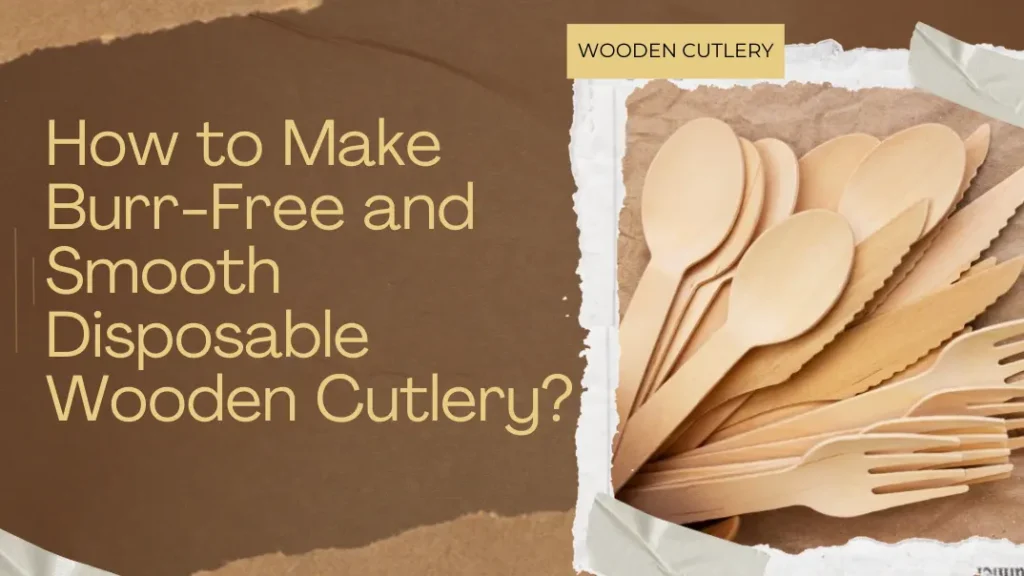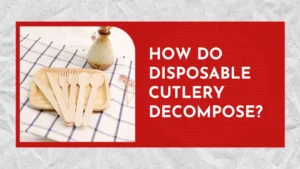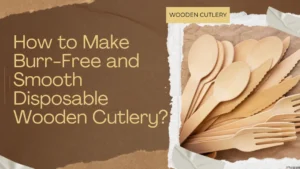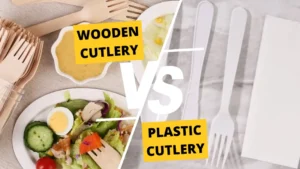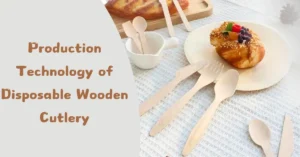Have you ever wondered how to create high-quality, burr-free disposable wooden cutlery? Do you struggle with rough edges or splinters affecting the finish? Is your current production process leaving too many imperfections? If you’re producing wooden cutlery, these questions directly impact your product’s quality and customer satisfaction.
Creating smooth and burr-free disposable wooden cutlery involves a series of well-defined steps, from selecting the right wood and machinery to applying the finishing touches. It’s all about precision in every step to ensure that each piece is smooth, safe, and ready for use.
Keep reading to uncover the essential tips and processes for making burr-free, smooth, disposable wooden cutlery that meets industry standards.
What is Burr-Free and Smooth Wooden Cutlery?
Making disposable wooden cutlery smooth and burr-free is not just a matter of aesthetics; it directly affects safety, durability, and the overall customer experience. Burrs and rough edges on wooden utensils can pose safety risks, such as causing cuts or splinters. Additionally, poorly finished cutlery can turn off potential customers, especially those looking for eco-friendly and high-quality alternatives to plastic.
The demand for disposable wooden cutlery has surged due to the global push for sustainability. Consumers are seeking products that are both environmentally friendly and functional. Smooth, burr-free cutlery looks appealing and is safer, ensuring a pleasant dining experience. Achieving this standard requires careful attention to materials, production processes, and finishing techniques.
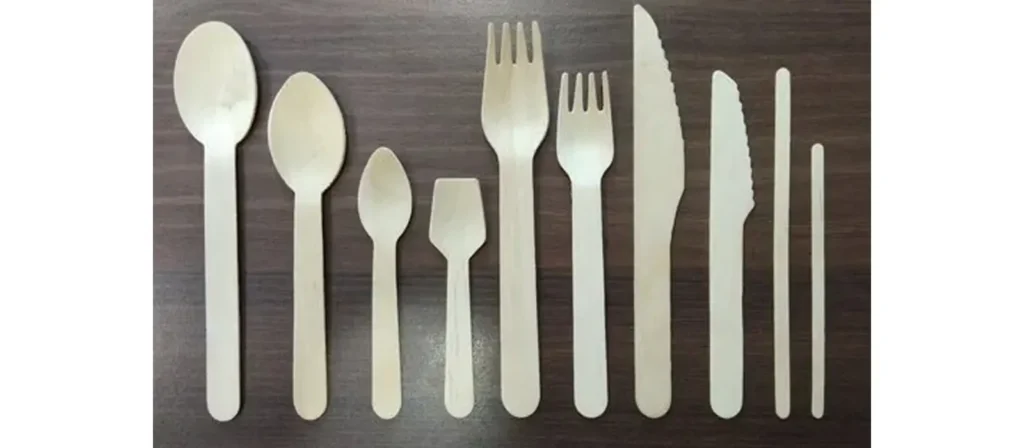
Why Burrs Form on Wooden Cutlery
Burrs can form at any stage of the wood-cutting process. They are typically created when the wood is forced against a cutting tool, such as a saw or knife. Factors like the grain of the wood, the type of tool used, and the pressure applied during the cutting process all play a role in the formation of burrs. Additionally, improper drying or handling after cutting can contribute to rough, uneven edges.
Materials Required to Make Burr-Free and Smooth Wooden Cutlery
Creating burr-free and smooth wooden cutlery starts with selecting the right materials. The materials chosen will affect the overall finish and quality of the final product. High-quality, dense wood ensures a smoother surface, easier sanding, and a more consistent finish.
Key materials include:
- Wood: High-quality hardwoods are essential for smooth cutlery. Materials such as birch, maple, and bamboo offer durability and smooth surfaces.
- Sanding Paper: Sanding paper of varying grit sizes is needed to smooth rough surfaces and edges.
- Finishing Oil or Wax: A natural finishing oil or wax enhances the wood’s smoothness, gives it a sleek finish, and protects it from moisture and wear.
- Cutting Tools: Precision cutting tools, such as CNC machines or laser cutters, ensure clean, sharp cuts without rough edges.
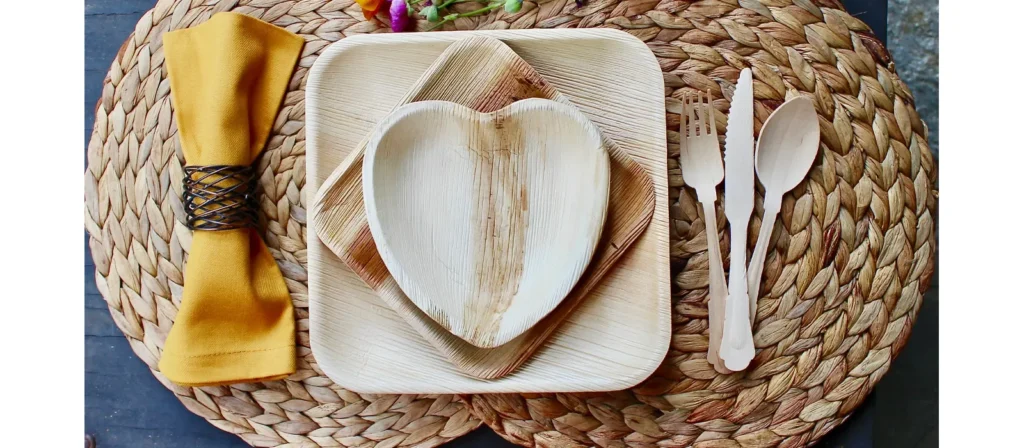
Types of Wood Suitable for Disposable Cutlery
Not all wood is created equal, and the type you use can directly impact the finish of your cutlery. For disposable wooden cutlery, you’ll want to choose wood that is relatively easy to shape and smooth out while still being durable enough for practical use.
Best Wood Choices for Cutlery Production:
| Wood Type | Benefits |
|---|---|
| Birch | Fine grain, smooth texture, easy to machine |
| Beech | Hard and durable, minimal splintering |
| Bamboo | Sustainable, naturally smooth |
| Poplar | Lightweight, cost-effective |
Choosing the right wood ensures that the cutlery remains smooth and enhances the overall quality and sustainability of the product.
The Role of Cutting and Shaping Machines
Once you’ve selected the right wood, the next step is cutting and shaping it into the desired shape. This is where the majority of burr formation happens if the process is not done correctly. Modern CNC (Computer Numerical Control) machines can help achieve precise cuts and shapes, minimizing rough edges and burrs.
Choosing the Right Machines
- CNC Routers: For cutting intricate shapes and curves.
- Laser Cutters: To create clean, precise cuts without fraying the edges.
- Milling Machines: These are used to create a finer finish and remove any irregularities in the wood’s surface.
Choosing machines with adjustable settings is important to fine-tune the cutting speed and pressure. Too much pressure can cause the wood to splinter, while too little can leave rough edges.
Step-by-Step Guide to Make Burr-Free and Smooth Disposable Wooden Cutlery
Making burr-free wooden cutlery requires a detailed, methodical approach to ensure every piece is smooth, safe, and durable. Below is an expanded, comprehensive guide to help you achieve high-quality, burr-free wooden utensils.
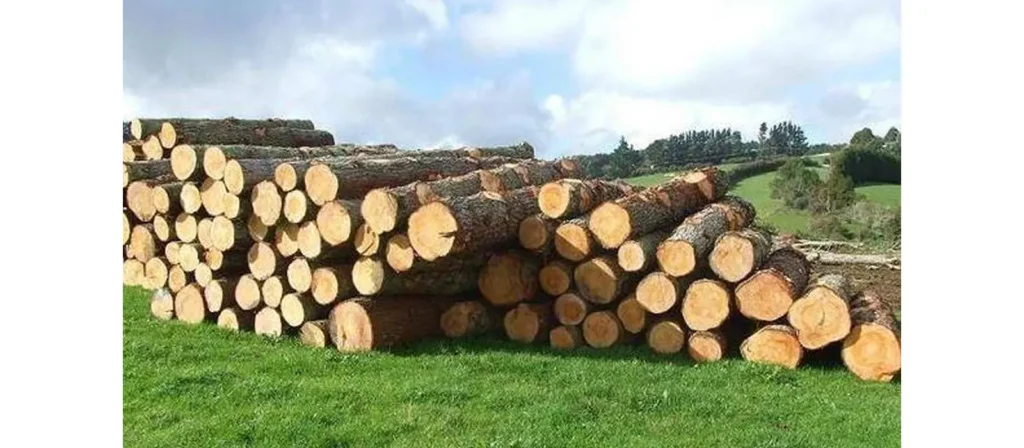
Step 1: Material Selection and Preparation
The first step in creating burr-free wooden cutlery begins long before cutting. The choice of wood and its preparation are crucial for a smooth, burr-free finish.
1. Select High-Quality Wood:
- Opt for hardwoods like birch, maple, or bamboo, as these tend to have fewer imperfections and a smoother grain than softer woods. Hardwoods are also more durable and less likely to splinter.
- Choose sustainably sourced wood to align with eco-friendly consumer expectations.
2. Dry the Wood Properly:
- Ensure the wood is properly dried to avoid warping or cracking, which can lead to rough spots.
- Kiln-dried wood is ideal, as it ensures uniform moisture content. Wood that has not been dried properly may expand or contract during the cutting process, causing uneven surfaces or burrs.
3. Inspect the Wood for Defects:
- Before beginning the cutting process, carefully inspect the wood for defects such as knots, cracks, or imperfections in the grain. Defects can lead to difficulties in cutting and increase the risk of creating burrs.
- Trim any rough or damaged parts of the wood to ensure a smooth, consistent surface for cutting.

Step 2: Cutting the Wood to Shape
Once the wood is prepped, it’s time to cut it into the basic shape of the cutlery. This step requires precision to ensure clean cuts without creating burrs or rough edges.
1. Use Precision Cutting Tools:
- CNC (Computer Numerical Control) machines or laser cutters are the best tools for creating clean, accurate cuts without generating burrs. These machines are programmed to follow precise measurements, leaving minimal room for error.
- CNC routers are particularly effective for shaping larger cutlery pieces like spoons, forks, or knives, as they provide consistency and smoothness.
2. Cut the Wood at the Right Angles:
- It’s important to cut along the grain of the wood whenever possible. Cutting against the grain can cause the fibers to splinter and create rough edges, which lead to burrs.
- When cutting, ensure the tool moves steadily and at a consistent speed to avoid uneven pressure, which can tear the wood fibers and leave rough areas.
3. Check for Burrs Regularly:
- After every cut, inspect the edges for any burrs or rough patches. If burrs are found, address them immediately before continuing with the next cut.
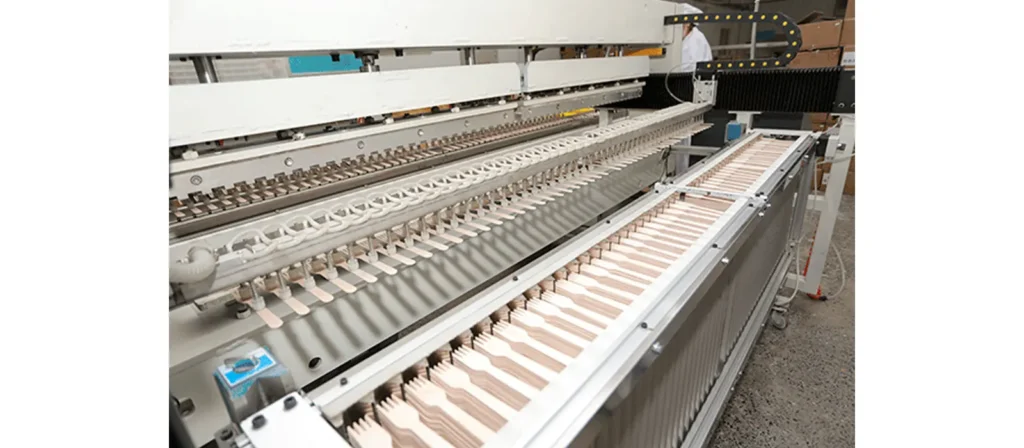
Step 3: Shaping the Cutlery
Once the basic shapes are cut out, the next step is shaping the pieces into the desired form. This process requires smooth handling to avoid leaving burrs or rough spots on the edges.
1. Use Shaping Tools to Refine Edges:
- Employ rasps, files, or wood scrapers to smooth out the rough, cut edges. These tools help refine the shape of the cutlery and ensure that the edges are straight and even.
- Always work in the direction of the wood grain to avoid splintering or burr formation.
2. Smoothing the Contours:
- At this stage, use hand tools or power sanders to shape the contours of the cutlery. For example, a small spoon gouge can help create the bowl without creating any imperfections if you’re shaping a spoon.
- Carefully shaping the handles and tines for larger pieces like forks or knives ensures they maintain strength and smoothness.
3. Check for Symmetry:
- Ensure that both sides of the cutlery are symmetrical. Even small asymmetries can lead to weak spots in the structure or uneven sanding later on.
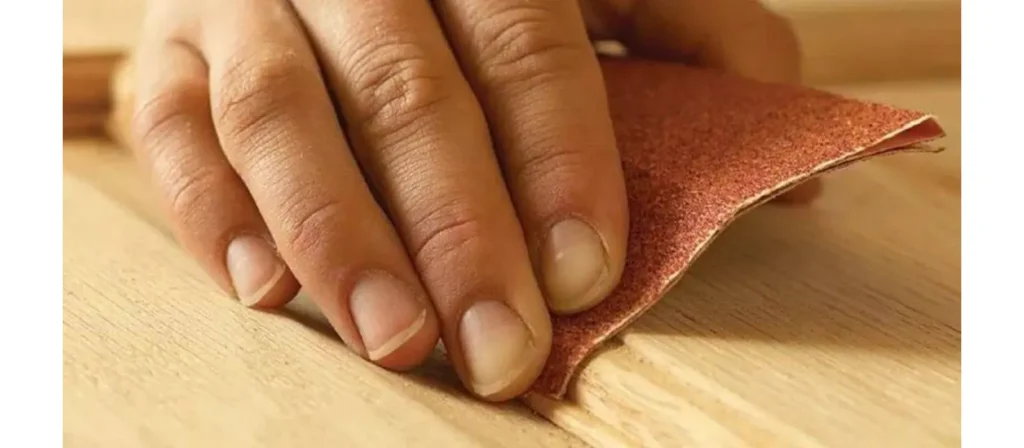
Step 4: Sanding to Smooth the Edges
Sanding is a critical step in achieving smooth, burr-free cutlery. Sanding helps eliminate rough edges, smoothens the surface, and prepares the wood for finishing. Proper sanding techniques are essential to avoid imperfections that could lead to burrs.
1. Start with Coarse Grit Sandpaper:
- Begin with coarse-grit sandpaper (around 80-120 grit) to remove any major imperfections, rough spots, or burrs. Focus on the edges of the cutlery where burrs are most likely to form.
- Use a sanding block or power sander to ensure even pressure across the surface.
2. Move to Medium Grit Sandpaper:
- After the major rough spots are smoothed out, switch to a medium grit sandpaper (around 150-180 grit) to further refine the surface.
- Sand the edges, curves, and hard-to-reach spots carefully to prevent uneven sanding.
3. Finish with Fine Grit Sandpaper:
- Once the rough sanding is done, switch to fine-grit sandpaper (around 220-400 grit). This final sanding step is crucial for achieving a smooth, polished surface.
- Sand the entire surface, including the edges and handle, paying close attention to ensure no rough patches or burrs remain.
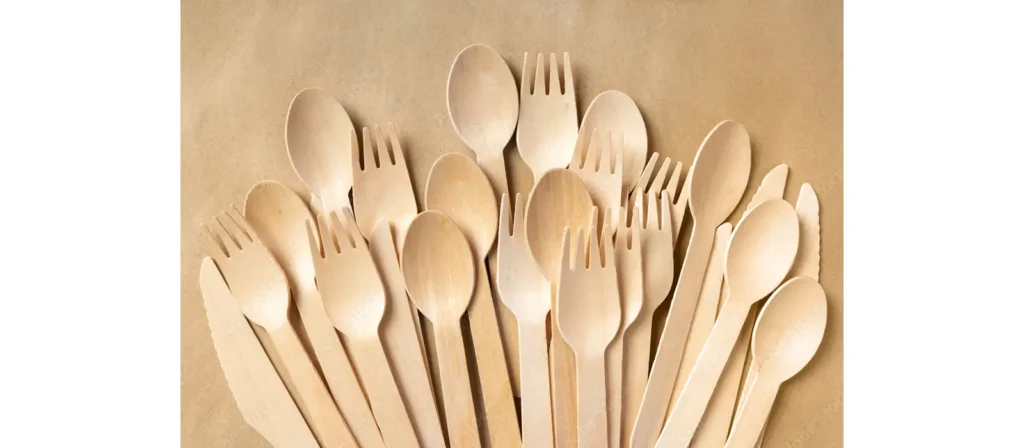
Step 5: Polishing the Wooden Cutlery
After sanding, your cutlery will need a polishing process to achieve a smooth, shiny finish that enhances the wood’s appearance and durability.
1. Apply a Natural Wood Finish:
- Once sanding is complete, apply a natural wood finish such as beeswax, carnauba wax, or linseed oil. These finishes enhance the wood’s smoothness and help protect the cutlery from moisture and wear.
- Applying wax or oil fills in minor gaps and provides a smooth, uniform coating.
2. Polish the Wood:
- Use a soft cloth or polishing wheel to buff the cutlery, ensuring a smooth, glossy finish. Buffing will also help spread the wax or oil evenly across the surface.
- Ensure that the cutlery is polished all over, including the handles and edges, to ensure consistency.
3. Allow the Finish to Cure:
- After polishing, let the cutlery rest for a few hours or overnight, allowing the finish to cure and harden fully. This step is crucial for achieving the desired protective layer and ensures a smooth, high-quality surface.
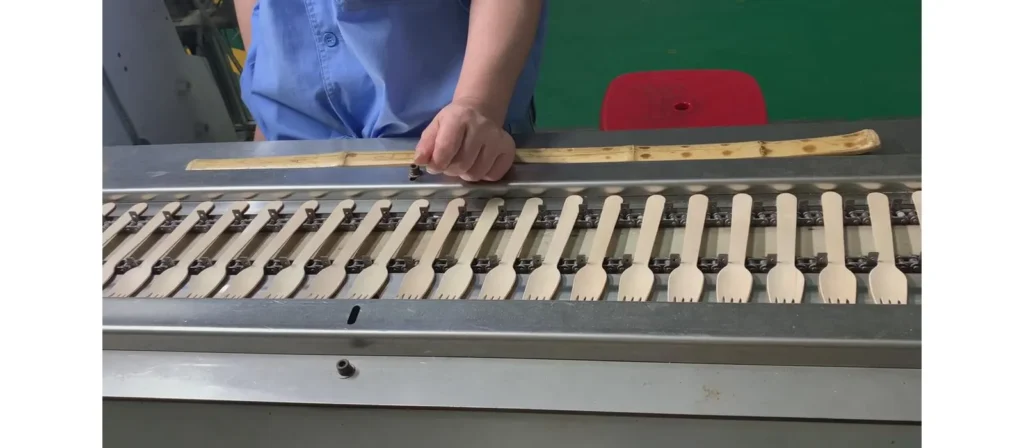
Step 6: Final Inspection
Once your wooden cutlery is fully polished, it’s time for the final inspection. This is your chance to check for any remaining imperfections.
- Visual Inspection: Carefully inspect the cutlery, checking for uneven areas, rough edges, or imperfections in the finish.
- Touch Test: Run your fingers along all surfaces, paying close attention to the edges and sanded areas. You should feel a perfectly smooth surface with no burrs or splinters.
- Automated Quality Control: Automated machines or scanners perform a final surface inspection in large-scale production. These tools can quickly detect small imperfections, allowing for quick fixes before packaging.
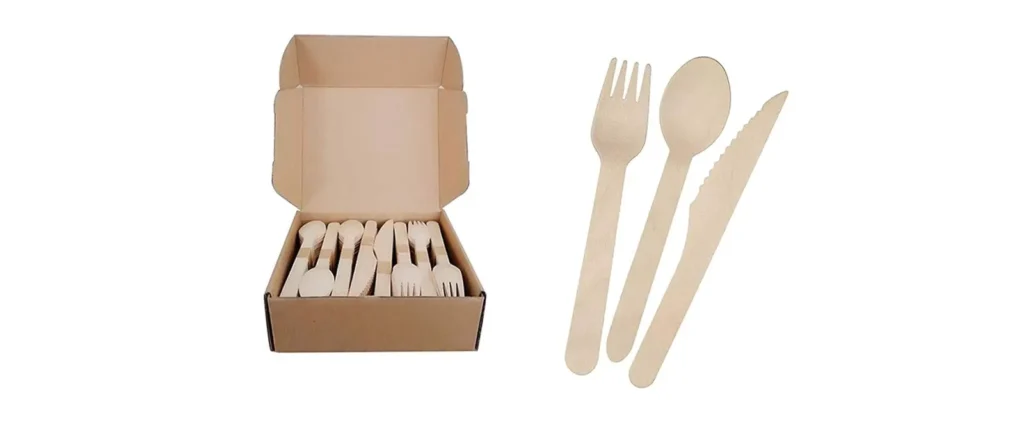
Step 7: Finishing Touches: Varnishing and Packaging
The final step in making burr-free and smooth disposable wooden cutlery is the finishing touches, which include varnishing and packaging.
1. Varnishing
Varnish or a food-safe finish can protect the wood and give it a glossy appearance. A non-toxic finish will ensure that the product is safe for food contact.
2. Packaging
Consider the environmental impact of your packaging. Using biodegradable or recyclable materials for packaging aligns with the eco-friendly values of many customers.
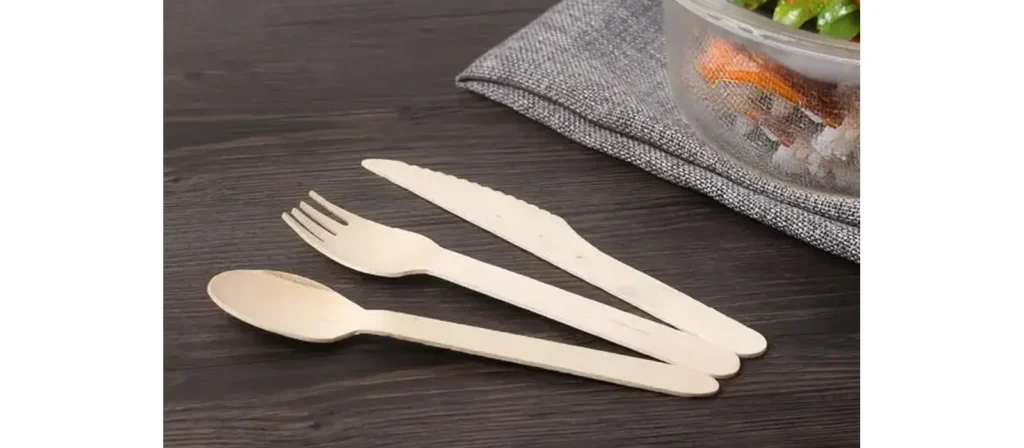
Benefits of Using Burr-Free and Smooth Disposable Wooden Cutlery
The growing demand for eco-friendly products has made disposable wooden cutlery a leading solution for sustainable dining. However, for these products to be effective, they must meet high quality, safety, and functionality standards.
- Improved User Comfort: Burrs and rough edges can cause discomfort when using wooden cutlery. Burr-free cutlery feels smooth and ensures a more pleasant dining experience.
- Safety: Wooden cutlery with burrs can splinter or break during use, posing safety risks. Burr-free edges reduce the chances of these issues, making the product safer for both children and adults.
- Aesthetic Appeal: A polished finish on wooden cutlery creates a premium look and feel, making it more attractive to consumers who appreciate quality and craftsmanship.
- Durability: Burr-free and properly finished wooden cutlery is more durable. The smooth surface is less prone to damage or wear, ensuring that the utensils maintain their integrity for longer.
- Eco-friendly: Choosing smooth, high-quality disposable wooden cutlery often benefits from using sustainable materials like bamboo or birch, making it more eco-conscious than plastic alternatives.
- Better Branding: A smooth, polished finish elevates the brand’s reputation for quality. Products that are aesthetically pleasing and well-crafted tend to be associated with higher standards, helping businesses gain consumer trust.
Market Demand and Trends for Disposable Wooden Cutlery
The demand for disposable wooden cutlery is growing rapidly as consumers and businesses become more eco-conscious. Wooden alternatives are gaining traction as people seek ways to reduce plastic waste. However, meeting this demand requires manufacturers to focus on quality and consistency.
- Eco-Conscious Consumers:
The push for sustainability drives consumers to seek out biodegradable and compostable products. According to recent surveys, many consumers are willing to pay more for eco-friendly products, particularly in the food service and hospitality industries. - Increase in Fast-Casual Dining:
With the rise of fast-casual dining and food delivery services, disposable cutlery has become necessary. As these businesses focus on providing a sustainable dining experience, the demand for eco-friendly alternatives like wooden cutlery has surged. - Regulatory Changes:
Many countries implement stricter plastic-use regulations, with bans or restrictions on single-use plastics. This has further pushed the adoption of sustainable alternatives like disposable wooden cutlery, which is biodegradable and safer for the environment. - Customization and Branding:
Businesses are increasingly using disposable wooden cutlery as a branding tool. Custom-engraved wooden cutlery or unique designs are gaining popularity in the food service industry, particularly in catering events, upscale restaurants, and eco-conscious businesses. - Innovation in Materials:
Manufacturers are also experimenting with alternative materials to improve disposable wooden cutlery’s strength, finish, and sustainability. For example, some companies use bamboo or birch wood, known for its strength and minimal splintering tendencies.
FAQs
- Why is burr-free wooden cutlery better than rough cutlery?
Burr-free wooden cutlery is safer, more comfortable, and has a more professional finish than rough, jagged alternatives. - What are the most common types of wood used for disposable cutlery?
Birch, bamboo, and maple are the most common woods used for disposable cutlery due to their smooth texture and durability. - What finishing products should I use for wooden cutlery?
Food-safe oils, such as mineral oil or coconut oil, and beeswax, are popular choices for finishing and protecting wooden cutlery. - Is there a growing market for disposable wooden cutlery?
Yes, the demand for disposable wooden cutlery is rising, especially as more consumers and businesses seek eco-friendly alternatives to plastic. - How do I ensure my wooden cutlery is burr-free?
Use sharp cutting tools, apply light pressure, and always sand the edges until smooth. - How long does it take to make smooth wooden cutlery?
Depending on the number of pieces and the detail involved in sanding and finishing, it can take several hours. - Can I make wooden cutlery without a CNC machine?
While CNC machines offer precision, manual tools can be used for smaller-scale production with careful attention to detail. - Can automated machinery improve the quality of wooden cutlery?
Yes, automated machinery like CNC machines ensures consistent, burr-free cutlery production.
Conclusion
In conclusion, creating burr-free and smooth disposable wooden cutlery requires attention to detail, materials, and advanced manufacturing processes. By following best practices, such as selecting the right wood, using precise cutting and shaping techniques, and implementing thorough quality control, manufacturers can produce high-quality wooden cutlery that is both functional and aesthetically pleasing.
The demand for eco-friendly, high-quality disposable wooden cutlery is increasing, and by perfecting the production process, manufacturers can cater to this growing market while ensuring customer satisfaction.

